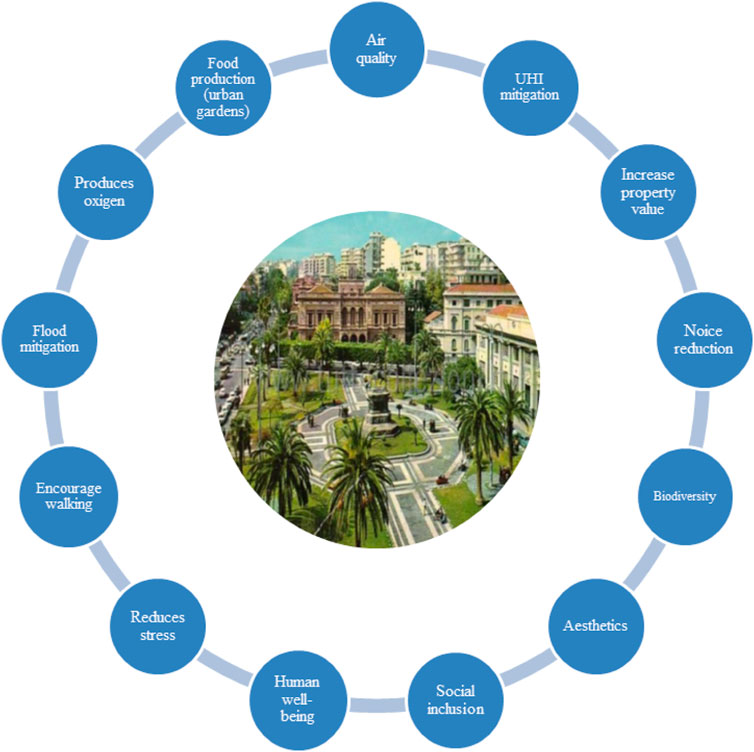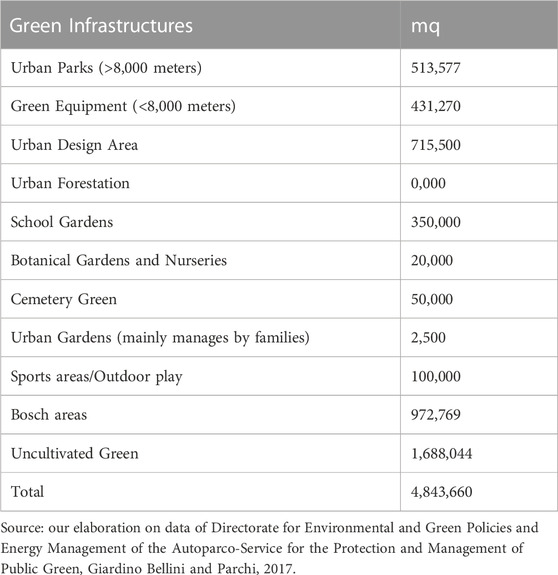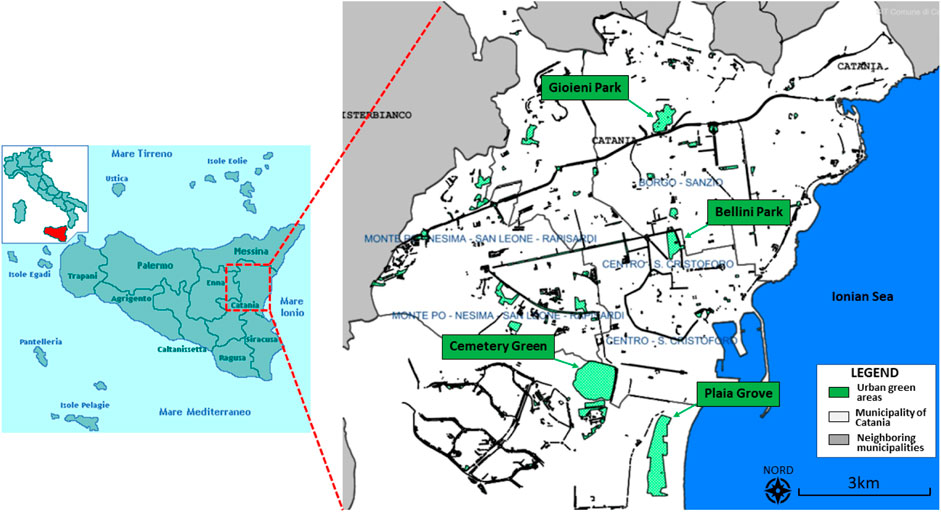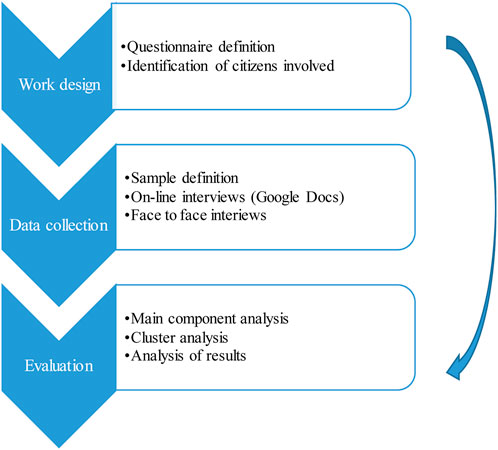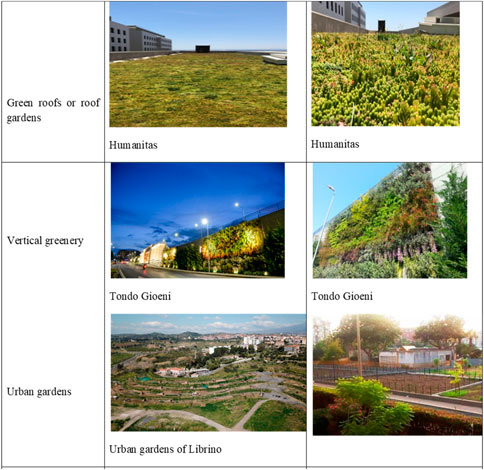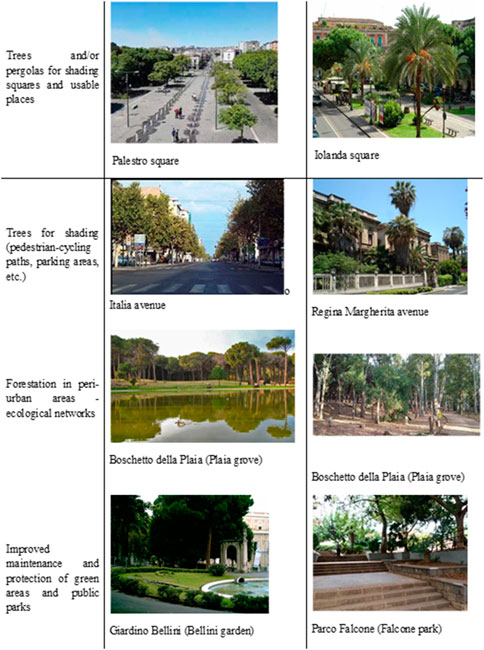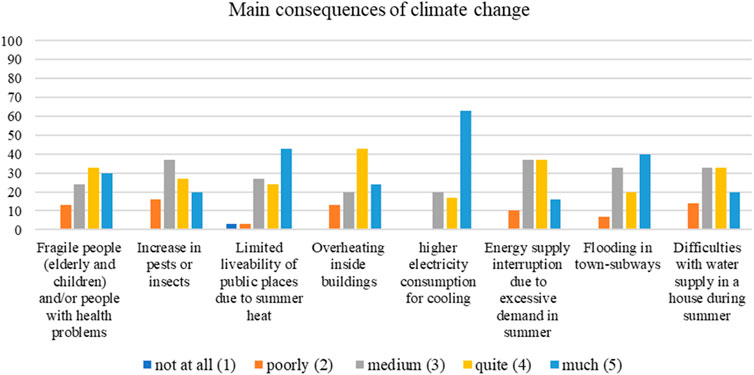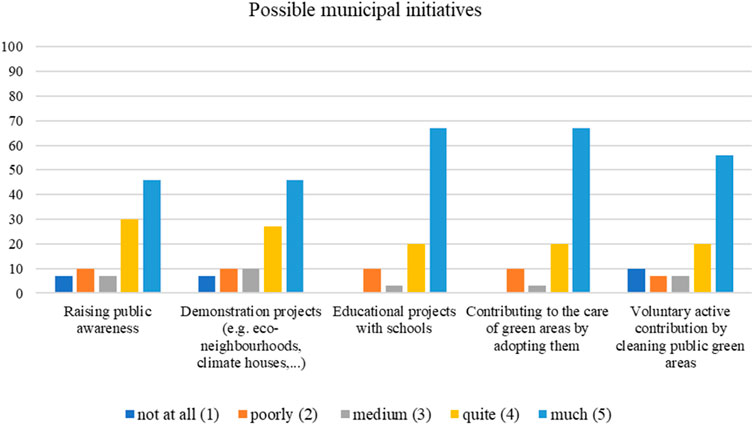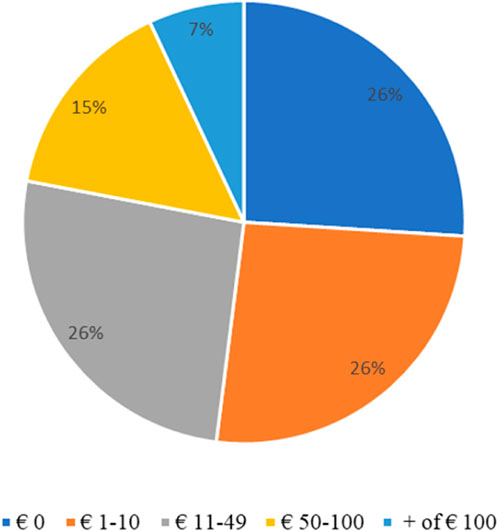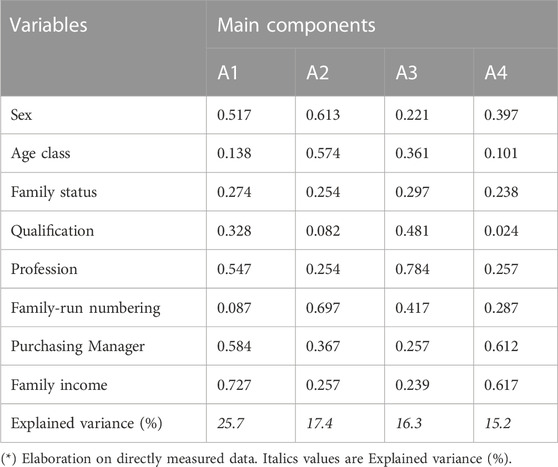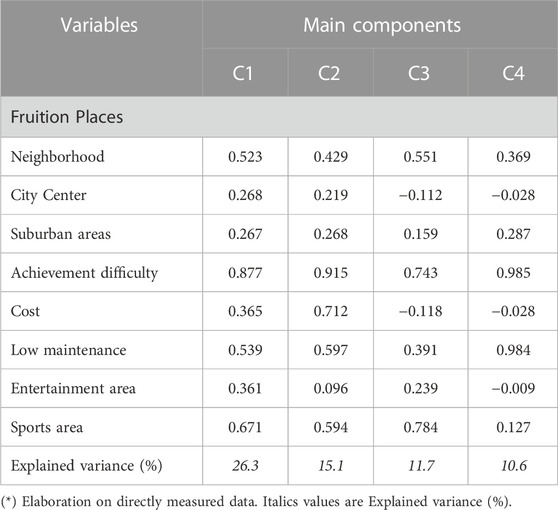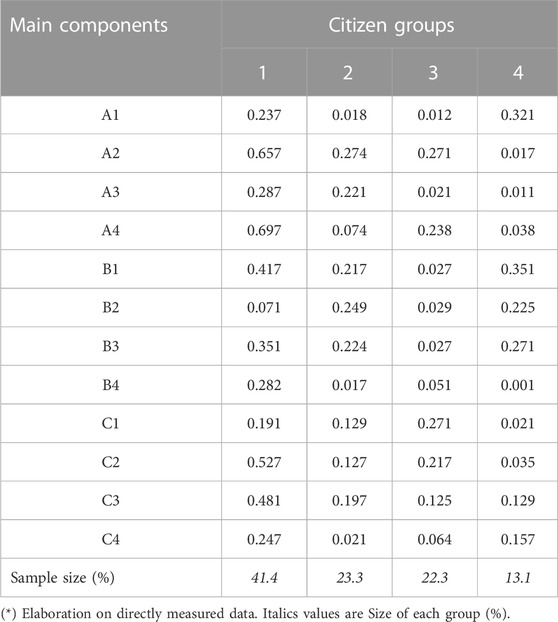- 1Department of Civil Engineering and Architecture (DICAR), University of Catania, Catania, Italy
- 2Agriculture Food and Environment Department (D3A), University of Catania, Catania, Italy
Climate change in recent years is shaping society’s habits and life in large cities, then it will be necessary to plan and design nature-based urban solutions to meet different interests and needs. To enable this approach between cities, urban green spaces and climate change, sustainable and resilient urban growth models are needed, planned with the contribution of citizens as priority stakeholders. Citizens perceive and attribute value to Green Infrastructures (GIs), albeit in relation to different socio-economic and environmental variables, the assessment of which has only recently been addressed in specific research. This research analysed citizens’ perceptions of GIs in combating the effects of the climate change. In particular, it revealed the degree of awareness of climate change, the value attributed to GIs and, finally, the willingness to pay to contribute to the maintenance of GIs in the city. The survey was carried out in the city of Catania (Italy), through the administration of questionnaires to a sample of residents (n = 500). The results show that the citizens involved perceive GIs as strategic elements of the quality of urban life, although they are not always aware of their positive impact on climate change. Interest in the co-management of GIs was higher in the case of crowdfunding. An integrated two-step methodological scheme was applied (divided in two phases, univariate and multivariate statistical analysis), which proved effective in analysing the different needs perceived by citizens. This approach could become a useful tool for planning GIs, especially in the current context in which cities are facing challenges related to climate change and changing societal needs. Understanding citizens’ views will be strategic in directing public investments towards GIs that can improve the quality of life in the urban ecosystem.
1 Introduction
The impact of climate change is increasingly evident in cities, where high population density, densely built structures and sealed surfaces are concentrated. Increasingly extreme weather events are leading to increased inland and coastal flooding, droughts and heat stress (Urban Heat Island (UHI) effect, the phenomenon whereby cities appear to be warmer than the surrounding rural area) (IPCC, 2007; IPCC, 2018; UNEP, 2019; FAO, 2020; IPCC, 2022). These changes lead to negative impacts from an economic, environmental and even social point of view, with damage to public health and safety (EEA, 2012; IPCC, 2018; UN, 2019; UNEP, 2019). The extreme events described above are putting cities and sustainable urban development at risk, and local authorities have a central role in promoting climate change adaptation measures.
In this context, Nature-Based Solutions (NBSs) are more and more used, especially because they are promoted by international governmental organisations and research that supports their sustainability (IPCC, 2014; EC, 2015; Maes and Jacobs, 2015; Kabish et al., 2016; Dorst et al., 2019). The NBS concept was originally created in the International Union for Conservation of Nature (IUCN, 2008) network in relation to climate change adaptation and biodiversity conservation. Later, it was taken over by the European Commission (E.C.), integrating social and economic objectives.
According to the EC definition, NBSs are “solutions to societal challenges that are inspired and supported by nature, which are cost-effective, simultaneously provide environmental, social and economic benefits and help build resilience” (EC, 2020c). They are systematic, resource-efficient and locally adapted interventions that aim to integrate natural processes into cities, landscapes and seascapes to help address the challenges associated with climate change. Beyond the definitions, the important aspect is that the objective of NBS remains to protect the human wellbeing, the biodiversity of nature and support the provision of Ecosystem Services (ESs) (Elmqvist et al., 2015; EEA, 2021).
According to the definition given by the Millennium Ecosystem Assessment (MEA, 2005), the ESs are “the multiple benefits provided by ecosystems to humankind.” Beyond the definition, the important consideration is that since 1997, the focus has been on the relationship between natural capital and the services produced. The ESs perform the following functions: environmental-regulatory; hydrological protection; social, recreational and therapeutic; cultural and educational; and aesthetic-architectural (Costanza et al., 1997; MEA, 2005; TEEB, 2008;.; Haines-Young and Potschin, 2010; Costanza et al., 2017).
The most frequently implementations of NBSs in urban areas are the Green Infrastructure (GIs), which are progressively being included in cities’ green plans as part of climate adaptation measures (Economides, 2014; Carrus et al., 2015; EC, 2015; Wei et al., 2018; Sturiale and Scuderi, 2019; EC, 2020b; Pamukcu-Albers et al., 2021).
According to the European Union (E.U.), the GIs “... are networks of natural and semi-natural areas planned at strategic level with other environmental elements, designed and managed in such a way as to provide a wide spectrum of ecosystem services. This includes green (or blue, in the case of aquatic ecosystems) and other physical elements in areas on land (including coastal areas) and marine areas. On the mainland, green infrastructures are present in a rural and urban context” (ED, 2013). Forms of GIs include green roofs, green walls, urban forests, urban green spaces, urban trees, bioswales, rain gardens, urban agriculture (urban gardens; community gardening; community greening; peri-urban agriculture, agricultural parks), river parks, local produce markets, constructed wetland areas, alternative energy farms, and nature conservation areas, among the most common (ED, 2013; Sturiale and Scuderi, 2019; EEA, 2021).
There are many researches and studies in the literature on the multifunctionality of GIs and their role in urban climate adaptaion (Forest Research, 2011; Foster et al., 2011; EC, 2012, 2016; The Nature Conservancy, 2016). In particular, tools and methodologies are being developed innovative models for green-oriented urban planning and collaborative governance (Raymond et al., 2017; Brink and Wamsler, 2018; Foti et al., 2018; Sturiale and Scuderi, 2018; Frantzeskaki, 2019; Giachino et al., 2022; Sturiale et al., 2022). In the urban system, NBSs are mainly represented by the different types of GIs, and their integration into urban planning seem to be one of the most appropriate and effective ways to address the impacts of climate change, to improve the urban microclimate and to protect the wellbeing of citizens (Figure 1).
Several studies show that there are important links between urban greenery and impacts on climate conditions: parks and trees provide shade and help cool the air, are places to find relief during heat waves, provide vegetation cover and protect from solar radiation; the integration of vegetation into building facades and roofs helps balance indoor temperatures and protect structures (Barò et al., 2014; Carrus et al., 2015; Elmqvist et al., 2015; Deng et al., 2017; EC, 2020 c; d; IPCC, 2018; Sturiale and Scuderi, 2019; Sturiale et al., 2022).
Today, more than 55% of the world’s population lives in urban settlements, a percentage that is set to rise to 68% by 2030 (UN, 2019). The vision of the future city is based on the model of resilient, socially just, carbon-neutral and nature-positive cities, which puts environmental and socio-economic sustainability at the centre (IPBES-IPCC, 2021; UNEP-UN-Habitat, 2021).
The resilient and sustainable city model requires the increased presence of new urban and spatial structures, energy-efficient buildings and infrastructure, the adoption of advanced technologies and the increase of GIs. These structures aim to mitigate global emissions and local pollution, promote adaptation to climate change, reduce energy costs for households and businesses, and improve the climate in cities.
GIs can help to create resilient cities that can counteract what has happened in the last century of intense urbanisation. As several researches have shown, recently GIs are starting to take on a strategic meaning by citizens, because they are no longer considered as a simple element of urban furniture, but as a fundamental tool to improve the quality of life in the city (Lohr et al., 2004; Sanesi and Chiarello, 2006; Qin et al., 2013; Camacho-Cervantes et al., 2014; Sturiale et al., 2020; Sturiale et al., 2022).
The community, in general, and citizens, in particular, are developing an awareness of the important role that urban greenery can play in improving the quality of life in cities and in combating climate change (Chiesura, 2004; Barò et al., 2014; Razak et al., 2016; Maruthaveeran, 2017). Numerous studies refer to the evaluation of the benefits of urban greenery by citizens, which recognis not only the aesthetic value, but also the social, environmental and strategic value for climate change. They document that citizens appreciate the environmental and aesthetic values of trees (Shacklet et al., 2015), but they also assign great importance to other values, albeit intuitively (Sanesi and Chiarello, 2015; Sturiale and Scuderi, 2019). In particular, they recognise the benefits related to the improvement of the quality of life (Sanesi and Chiarello, 2015), the improvement of urban quality and aesthetic value (Shacklet et al., 2015), the social value of urban green spaces (both as a place of social aggregation and as a place for the recovery of marginal categories—this is the case of urban gardens) (Shacklet et al., 2015; Foti et al., 2018; Sturiale and Scuderi, 2018; Scuderi et al., 2021), to the role they play as climate adaptation measures (Razak et al., 2016; Derkzen et al., 2017; Chiw and Ling, 2019; Sturiale and Scuderi, 2019; Mortoja and Yigitcanlar, 2022). Studies indicate that citizens are increasingly aware of environmental problems and demand greater involvement in actions concerning urban climate change in their cities (Zerva et al., 2021; Taylor et al., 2014). Furthermore, they highlight the importance of investigating the perception of climate change among citizens and developing co-participative governance models for urban greening strategies shared with the population. (Sanesi and Chiarello, 2006; Vignola et al., 2013; Camacho-Cervantes et al., 2014; Ballew et al., 2020; Sturiale et al., 2020, 2022;.; Wicki et al., 2021; Zerva et al., 2021; Chitsa et al., 2022; Skains et al., 2022).
Information on the degree to which citizens perceive the benefits of urban green in general and their effects on climate change can play a strategic role in urban green planning. Several studies have already shown evidence of a link between urban greenery and quality of life and climate change (Nowak, 2002; Nowak et al., 2006; Georgi and Zafiriadis, 2009; Klemm et al., 2015; Shacklet et al., 2015; The Nature Conservancy, 2016). But it is necessary to deepen among citizens the degree of knowledge of the benefits produced by green, on the one hand, and their degree of participation in the planning and management of urban green (also in economic terms, with payment of taxes or one-off contributions), on the other.
There are several recommendations coming from various levels, Intergovernmental Panel on Climate Change (IPCC), United Nations (UN), Food and Agriculture Organization (FAO) (to mention a few) calling for the development of a greater participation of citizens in the planning of mitigation and adaptation strategies, as well as raising awareness of the importance of urban greenery for the success of urban adaptation policies. Many studies have investigated the perception of climate change, both in terms of communication and community perception (Deng et al., 2017; Lorenzoni et al., 2006; Marin and Berkes, 2012; Pasquaré and Oppizzi, 2012; Palermo and Hernandez, 2020; Von Storch et al., 2017; Scuderi et al., 2021; EC, 2021a). On the other hand, there is a limited amount of research on the degree of public perception of the importance of urban GIs and the ESs that they provide and their role in combating climate change (Gill et al., 2007; Foster et al., 2011; Demuzerea et al., 2014; Jayasooriya et al., 2017; Sturiale and Scuderi, 2019; EC, 2020d; EC, 2021; Pamukcu-Albers et al., 2021; Ramyar et al., 2021). Understanding the perception of the phenomenon is important in order to provide adequate suggestions to citizens and involve them in collaborative governance processes according to a sustainable and resilient urban development approach.
The proposed study aims to find out citizens’ perception of GIs in combating the effects of the climate change, considering the city of Catania (Italy) as a case study. The analysis was conducted on a sample of resident citizens (n = 500), with the administration of a questionnaire useful to acquire information on the degree of awareness of climate change, the value attributed to GIs and, finally, the willingness to pay to contribute to the maintenance of the city’s GIs. An integrated two-step methodological scheme was applied (divided in two phases, univariate and multivariate statistical analysis), which proved to be effective in the analysis of the different needs perceived by citizens and could become a useful tool for GIs planning, especially in the current context where cities are facing challenges related to climate change and changing societal needs. The paper, after providing a brief overview of the role of GIs in the resilient and sustainable urban model (par. 2), presents the Catania case study (par. 3), the methodological approach employed (par. 4), the results (par. 5) and, finally, presents a discussion of the main results obtained (par. 6).
2 The importance of the NBSs and GIs in new models of sustainable and climate resilient cities
The issue of climate change is being brought up in the international debate, following an increasingly methodical and precise collection of scientific information that allows us to investigate the evolution of the climate system and its relations with ecological, social and economic systems (IPCC, 2007; IPCC, 2018; UNEP, 2019; FAO, 2020; IPCC, 2022). The role that nature can play in combating climate change is fundamental, precisely because there is a close interconnection between the loss of biodiversity and climate change. If the climate and biodiversity loss crises are linked, the solutions are also linked and nature becomes a vital ally in the fight against climate change (IPBES-IPCC, 2021; MITE, 2021).
The growing importance of NBSs and, in particular, of GIs in the urban context for a new model of resilient and sustainable urban development is acknowledged at a political level. At the European level, the European Green Deal (EC, 2019), an growth strategy based on climate neutrality, also sees NBS as important tools to increase resilience to climate change and to conserve the EU’s natural ecosystems. In fact, they are included among the actions in the new EU Biodiversity Strategy 2030 (EC, 2020a) and in the new EU Climate Change Adaptation Strategy (EC, 2021b).
The FAO (FAO, 2020) believes it is urgent to develop more sustainable and resilient urban growth models, in which NBSs could play a strategic role, as also highlighted by the IPCC (IPCC, 2022). The growing importance of bringing nature back into urban ecosystems, which have been characterised by progressive overbuilding in recent decades, has also been underlined in the Agenda 2030 of the UN (UN, 2015), In particular, among the 17 Sustainable Development Goals (SDGs) of the Agenda 2030, the following goal is envisaged: Goal 11, Sustainable Cities and Communities, specifically dedicated to urban systems, and its goal is to “make cities and human settlements inclusive, safe, resilient and sustainable.” In particular, Goal 11 defines several targets that promote intelligent urban planning that creates safe, affordable and resilient cities with green and culturally inspiring living conditions (UN, 2015).
In Italy, the importance of the presence of green spaces in urban areas, has also been recognised at a regulatory level. We recall, in particular, Law n. 10 of 14 January 2013, Rules for the development of urban green spaces, in which the following ESs are recognised:
- provision services: supply of food, food forestry, soil stability, biodiversity conservation;
- regulating services: air quality, climate improvement, hydrogeological risk regulation;
- socio-cultural services: landscape value, recreational value, social relations, cultural growth and health.
Other measures have recognised the role of social agriculture (Law No 141 of 18 August 2015) and actions to recover degraded areas and buildings, both for social purposes and to reduce land consumption (responding to the EU directive to achieve 0% land consumption by 2050) (Sturiale and Scuderi, 2018). Italy has developed a National Strategy for Biodiversity 2030 (which follows that of 2011–20), in line with the conservation and restoration goals of the European Biodiversity Strategy 2030 (EC, 2020a), which confirms the 2050 Vision, which calls for all the planet’s ecosystems to be restored, resilient and adequately protected, takes into account the value of biodiversity for combating climate change, health and the economy, and contributes to the achievement of the 2030 Agenda objectives.
There are many recent experiences undertaken by cities to increase the GIs to counteract the impacts of climate change in the first place. Maintaining the functional capacity of GIs to mitigate the negative effects of climate change is far more beneficial than replacing these lost services with artificial technological solutions that are far more costly in terms of time and effort.
In the United States, several cities have planned the development of specific GIs (New York, Chicago, Philadelphia, Washington D.C.) or have foreseen their presence in climate protection action plans (San Diego) (Economides, 2014). In New York, roofs will be transformed into green roofs, as decreed by a recent law making them compulsory, a measure included in the so-called Climate Mobilization Act (2019), which will make the metropolis more sustainable.
In Europe, climate adaptation plans and experimental projects for the creation of sustainable eco-neighbourhoods have been adopted or are being developed, with the design of large areas of urban or suburban green space. The aim is always to introduce climate adaptation measures, on the one hand, and to regulate urban sprawl and the increasing consumption of land, on the other.
Examples of the many initiatives include the UK’s Green Belts (in UK urban planning) and Barcelona’s AnellaVerda. Paris has decided to plant 170,000 trees, because the administration decided to design new green spaces to make the French capital a resilient city to climate change and to offer a greener and more inclusive city to its citizens (as Amsterdam is already doing) Other projects and studies concerning the progressive inclusion of different forms of GIs in the green planning of cities can be found from Europe to Asia: in Copenhagen (Caspersen and Olafsson, 2010), Berlin (Kabish, 2015), Seoul, Shangai, Hong Kong (Jim, 2002), Beijing (Yang et al., 2005), and Nanjing’s Pukou District (Wei et al., 2018).
In Italy, we mention the vertical forest in Milan; the Green Belt in Turin; the green ring in the municipality of Mirandola (Modena); the urban gardens in Catania (Pietrapertosa et al., 2019; Sturiale and Scuderi, 2019; Serra et al., 2022; Sturiale et al., 2022). Milan has set itself the objective of planting 30 million trees, following the same goals as other cities engaged in this “urban re-greening” action, making up for the gap that characterises Italian cities, which are a little behind in this “urban green revolution” (FORESTAMI Project, 2020). The importance of the “natural capital” of an urban area concerns not only architectural and urban planning aspects, but also and above all ecological-functional, social and economic aspects.
3 Study area: Catania (Italy)
The city of Catania covers an area of 180,000 m2, with approximately 350,000 inhabitants and a density of 1.7 inhabitants per square metre. It is the second largest city in terms of size, surface area and inhabitants in the Region of Sicily. Planning is still regulated by a Regulatory Plan, drawn up in 1964, designed for the socio-economic needs of a society in the 1960s, with priorities and a vision completely different from those of today. This is especially true in terms of environmental protection, attention to climate change and social inclusion. In relation to the socio-economic development of the city, environmental protection and the problems of climate change, the municipal administration has planned a programme of measures to enhance the existing GIs in the city and to design new GIs, especially as climate adaptation actions.
In the city of Catania (Kmq 183) the extension of the GIs is equal to 4,843,660 square meters, and the urban green per inhabitant corresponds to 16.4 square meters. The GIs in the city of Catania are the following types (Table 1).
The location of the GIs in Catania is shown in Figure 2, in which the labels corresponding to the largest green areas are highlighted, while the other types of GIs are distributed somewhat throughout the city, from the centre to the periphery. The GIs in the municipal territory play an important specific role both as an urban component, for the conservation and improvement of the landscape and the environment, and as a means for aggregative purposes for social and cultural integration.
The GIs implementation projects, in accordance with Legislative Decree No. 50/2016, aim to achieve several objectives, including.
• to improve and preserve the local landscape and environmental restoration;
• to favor urban climate control and reduction of albedo and heat islands;
• to increase the naturalness and biodiversity of the urban territory;
• to stimulate the aggregative, social and therapeutic functions of green areas (e.g., urban gardens, neighborhood parks, healing gardens, spaces for cultural events and shows) (Regulation of the public and private Green of the city of Catania, 2017).
In the last few years (since 2018), the municipality of Catania has launched a series of initiatives to promote the collaboration of citizens and/or private institutions in the management of green areas in different parts of the city (through the greening of squares, the care of flowerbeds, the cultivation of urban gardens, etc.) (Figure 3). Certainly, these are initiatives that allow citizens to take an active part in the care of the city’s “natural capital,” but above all they aim to draw greater attention to the benefits that the complex system of urban GIs brings to the community, in social, environmental and climatic terms.
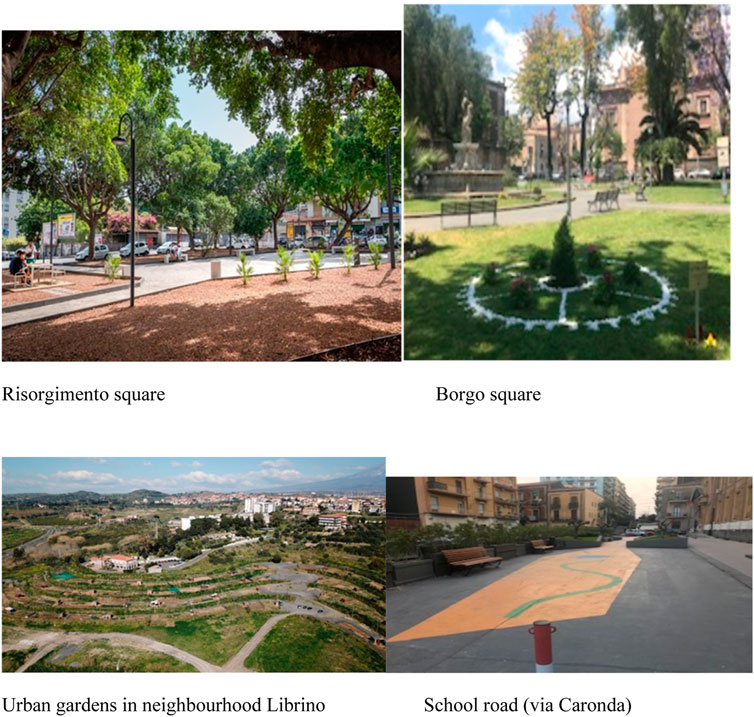
FIGURE 3. Some GIs in Catania, realised by the municipality in collaboration with citizens and private institutions (authors’ photos).
4 Methodology
The research on the degree of perception of GIs and on the impacts of climate change was carried out in the city of Catania, intercepting the citizens through a questionnaire. The analysis was carried out on a sample of 500 citizens. The size of the sample was fixed, taking into account the objectives of the research and the available resources, while the units to be interviewed were identified using the quota sampling method (non -probabilistic sampling for which only the total simple size in some significant strata is fixed a priori—sex, age strata, ecc.); this method, appears to be the most widely used in market surveys because compared to other sampling methods, it is very flexible (Wooldridge, 2002; Gujarati, 2003). The information and the data collected with the questionnaire have been elaborated according to a methodological scheme (Figure 4) already used for the study of the characteristics of the behavior of the citizen towards the urban green and the quality of the life (Lo and Jim, 2010; Faehnle et al., 2014; Xu et al., 2020).
4.1 Survey: The questionnaire
The survey was conducted through a “GoogleDocs” platform and through direct interviews “face-to-face,” during events in which the University of Catania was involved and in which the participation of citizens was expected. A specially prepared questionnaire was submitted in order to collect a set of quantitative and qualitative information on the various socio-demographic and cultural aspects of the interviewees, as well as on their behaviour towards GIs, their level of knowledge and perception of the quality of life and their willingness to support GIs, the perception of the climate change problem.
The questionnaire contained questions with closed or constrained answers (binary or multiple). The questions were qualitative, useful for codifying the opinions expressed by citizens, and quantitative, with numerical responses aimed at identifying frequencies and modes of use, as well as describing socio-economic characteristics. The questionnaire was structured in introductory part and other five parts, with a total of twenty questions and n. 1 photo sheet.
The introductory part involved the collection of socio-demographic information on the interviewee, through an anagraphic form (gender, age, permanent residence in Catania, area of residence in Catania, qualification, work sector). In order to understand the area in which the interviewees live, the territory of the city was divided onto the following neighbourhoods: Historical Centre, Borgo-Sanzio, Picanello Ognina Barriera Canalicchio, Cibali-San Giovanni Galermo, Monte po-Nesima-Rapisardi, San Giorgio-Librino-San Giuseppe La Rena-Zia Lisa.
Part one enquired about the evidence of climate change in the city of Catania. The second part aimed to collect citizens’ opinions on whether climate change is already having an impact on the city and on the quality of life. The third part was also designed to find out what citizens think about the importance of GIs in the city. The fourth part aimed to ask whether the city’s GIs (parks, tree-lined avenues, gardens, urban gardens, vertical greenery, green roofs, etc.) can help adapt to the effects of climate change. To facilitate the response, a photo sheet with the main GIs in the city was provided (Figures 5, 6). In addition, it was asked what possible initiatives the municipality could undertake to inform citizens about climate change.
The fifth part of the questionnaire was dedicated to understanding how citizens were really willing to participate in the fight against climate change for the improvement of their city. In particular, the questionnaire asked how much money they were willing to occasionally spend on restoring these areas. In addition, the survey asked if they were in favour of the proposal to have the degraded green areas managed by a private company, raising funds through crowdfunding among the inhabitants of the neighbourhood, allowing them to reduce the amount paid in municipal taxes.
4.2 Analysis
The information and data collected were processed according to an integrated methodological scheme, divided into two phases, paying particular attention to the last one in order to reach and better explain the typological characteristics of the groups of citizens.
In the first phase, we proceeded to describe the sample as a whole, using the tools of univariate statistical analysis, in order to outline the knowledge of the respondents towards green infrastructures and climate change. Using univariate descriptive statistics, the research took into account the characteristics of the population of the sample surveyed. The characteristics analysed were demographic, social and economic in nature: gender, age group, marital status, educational qualification, residence, profession, family size and household income. The data through the frequency distribution provided a description of the population in categorised classes in relation to the green infrastructure approach.
The next phase involved the application of multivariate statistical analysis techniques in order to highlight the main variables that affect the use and perception of GIs in metropolitan cities (analysis of the “main components”) and identify homogeneous groups of citizens (clusters) (Kaiser, 1958; Hair et al., 2007). Initially, the analysis of the “main components” was conducted in order to verify which variables, among those detected, are able to “define” the approach to the use of green areas; this in order to achieve and summarize the description of the phenomenon. The extraction by “blocks” of each homogeneous group of variables was preferred, using the Varimax method which allows, through the orthogonalization of factors, a simpler and more correct interpretation of the same (Kaiser and Rice, 1974).
The verification of the statistical model took place through the KMO Test to ascertain the goodness of approach of the hypothesized model to the data (Kaiser et al., 1974); as for the number of factors extracted, those with “eigenvalues” that assumed a value greater than 1 were considered (Kaiser and Rice, 1974).
The principal component analysis was followed by the application of cluster analysis to the values assumed by the factors previously extracted, which allowed the identification of homogeneous groups of users, using the procedure of non-hierarchical classification of k-means (k-means cluster analysis) that allows to define, through an iterative process, the clusters minimizing the Euclidean distances assumed by the centroids.
5 Results
5.1 Socio-demographic characteristics of the sample
The socio-demographic composition of the interviewed sample (n = 500) is described below. With regard to gender, 74% women and 26% men were interviewed. With regard to age groups, 40% belonged to the 50–65 age group, 23% were between 35 and 50 years old, 20% belonged to the 18–25 age group and the remaining 17% were between 26 and 35 years old. The age groups analysed provide a cross-sectional assessment that focuses more on the category of mature and aware people. 83% of the citizens involved live permanently in the city of Catania, while 17% stated that they do not do so permanently, a fact that confirms the considerable reliability of the answers, since the majority of the people interviewed were directly interested in the fruition of the urban green areas of Catania and the related climate problem.
With regard to the distribution of respondents among the neighbourhoods considered, 50% of the citizens who took part in the survey stated that they lived in the Borgo-Sanzio neighbourhood, 37% in the historic centre, 10% in the Picanello-Ognina-Barriera-Canalicchio area and the remaining 3% in the Cibali-San Giovanni Galermo neighbourhood. The composition according to neighbourhoods allows us to have both a real distribution according to the importance of the neighbourhoods and also according to potential urban green redevelopment works.
Information was also collected on the qualifications and type of employment of the respondents. As a level of education, 47% said they had a university degree, 30% a master’s degree and 23% a high school diploma. Regarding the type of occupation, 30% of the respondents answered that they work at university, 20% in commerce and communication, 14% work in schools, 10% in industry, 7% in local public authorities, 6% in health, another 6% said they are students, 3% are employed in agriculture and the remaining 4% in associations.
5.2 The perception of urban green and climate change
Regarding the evidence of climate change in the city of Catania, 47% of citizens said these effects were already quite visible. In particular, 30% said they were still moderately and 23% said the effects were very noticeable. The 100% of respondents said that the climate change is already having an impact on the city and on the quality of life. According to the interviewees, the consequences of climate change in the city are most related to increased use of electricity (during the summer period to cool rooms), extreme rainfall events (in the autumn period) and limited liveability of public places due to summer heat (effect UHI). Less important, but still meriting attention, are also the answers concerning the impacts on fragile people and water supply in the summer period. In order to understand the main consequences of this statement, Figure 7 shows the results for each category considered and the response percentages obtained.
According to the interviewees, the main benefits of the GIs in the city are: temperature control (cooling), air purification, carbon dioxide uptake, promotion of physical and mental wellbeing, conservation of urban biodiversity, use for leisure activities, landscape fruition, contact with nature. The other benefits included in the response are considered but with lower evaluation (increase in property value, rainwater regulation, noise reduction).
On the timeliness of action to adapt to impact of climate change in Catania, 60% of respondents answered that it would be very important, 34% that it would be quite important, 3% said that early intervention would have a medium improvement and 3% that it would have little improvement. According to the citizens involved in the survey, the GIs in Catania (parks, tree-lined avenues, gardens, urban gardens, vertical greenery, green roofs, etc.) could help the city adapt to the effects of climate change. In relation to this, in fact, 94% of citizens agreed that they could make an improvement in terms of adaptation, while 6% said no.
Figure 8 shows the opinions of citizens concerning the actions that the Catania City Council should undertake to raise people’ awareness on climate change. In general, the proposed initiatives received consensus but, in particular, education projects with schools and the possible adoption of green areas by citizens were the most appreciated. Voluntary cleaning of green areas also registered a good level of interest, while initiatives aimed at the demonstration of specific projects and public awareness seem less interesting.
Citizens also provided suggestions on possible practices and measures that the city administration could take to improve the status and use of the city’s GIs. Below are the most relevant.
• greater care of existing green spaces;
• restoring urban green spaces to decorate the city’s main streets;
• planting trees and caring for traffic islands;
• maintenance of existing green areas and improvement of use;
• focus on squares.
With reference to possible actions to be taken on the Catania GIs, citizens expressed their preferences according to the following percentages.
20% design of usable green areas;
20% greater protection and care of green spaces;
27% improved maintenance (street furnitures, fountains, ecc.);
33% increasing green spaces in areas of public use.
In order to understand the level of citizens’ knowledge about the actions undertaken by the municipality of Catania, they were asked whether they were aware of the authorities’ intention to draw up an Adaptation Strategy to cope with the expected impacts. 64% of them said they were not aware of it, while 36% said they knew about it. Regarding the possibility of being able to participate in the discussion process with local institutions for the implementation of the Adaptation Strategy, 64% showed interest in participating, while the rest of the sample was not interested.
Regarding the real degree of citizen participation in the fight against climate change for the improvement of their city, the 57% of the respondents answered that they would be partly willing to support the improvement of a green area in their neighbourhood, while the remainder is not willing to contribute. They were therefore asked how much money they would be willing to spend occasionally on restoring these areas, choosing among classes of value ranging from € 0 to over € 100. The willingness of citizens to contribute to the maintenance of green areas is shown in Figure 9, which shows that the willingness to pay € 0 and the monetary ranges between € 1–10 and € 11–49, each collect 26.0%.
Finally, with regard to the possibility of being able to participate in the management of green areas by crowdfunding among neighbourhood residents, making it possible to reduce the amount paid in municipal taxes, 86% responded positively. The same amount classes were considered as in the previous question and the respondents almost reversed their answers. Specifically, the annual contribution they were willing to make in exchange for a reduction in municipal taxes (Figure 10) in the majority (36%) was in the € 11–49 class, while 14% said they would not contribute.
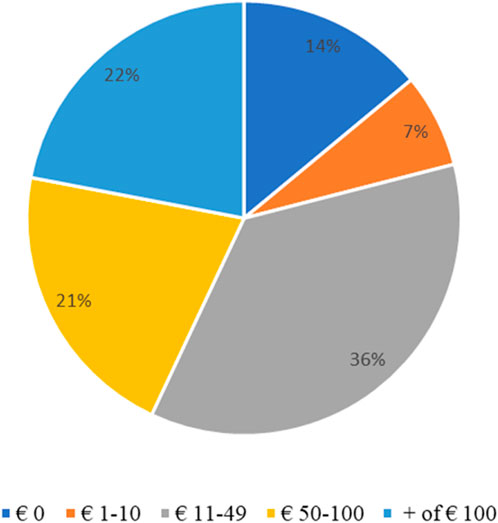
FIGURE 10. Citizens’ availability to contribute in case of a tax reduction for the improvement of green areas in the city.
5.3 Citizen groups: Cluster analysis
5.3.1 Main components analysis
Twelfe main components that have been identified summarize information regarding the characteristics of the citizens interviewed. The first group of variables considered, as shown in Table 2, are the socio-economic ones, and among those found only 8 were able to explain 70.3% of the overall variance, through the extraction of 4 components (A1; A4).
The first component extracted (A1) alone explains 25.7% of the variance and describes the characteristics of a part of the sample interviewed represented by a nucleus of young male individuals who carry out a non-stable work activity; in fact, these variables are positively correlated (values >0) among themselves and with a diploma level qualification and a medium-low annual family income.
The second component (A2), with 17.4% of the variance explained, is characterized by the population of middle-aged, married women who take care of the family, being responsible for the household. In fact, these variables are strongly positively correlated with each other (values >0). The third component extracted (A3), with 16.3% of the total variance explained, highlights the middle class of the sample, medium in number, characterized above all by the male component who takes care of the family as not very interested in GIs. The fourth component (A4) explains 15.2% of the variance and highlights and binds through positive correlations the professional condition of employee with a high level of education.
The second group of variables, as shown in Table 3, refers to the general characteristics of the perception of urban green, those statistically significant were 8 that through the application of principal component analysis allowed to extract 4 components (B1; B4) that explain 78.7% of the total variance.
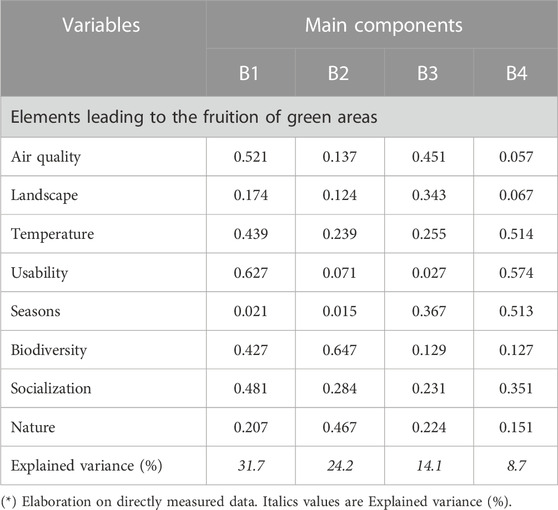
TABLE 3. Rotated matrix of the components relating to the general characteristics of GIs preference (*).
Specifically, the first component (B1) (31.7% of the variance) summarizes the reasons that lead to the use of green areas by citizens. In this regard, the frequent use of GIs can be ascribed to improved air quality and reduced temperatures. The positive correlations of the variables (values >0) with socialization as a meeting place, highlights the role played by these areas as a function of aggregation even in different age groups.
The second component extracted (B2) (24.2% of the variance) indicates that the use of the green areas is perceived as areas of socialization associated with a moment of leisure aggregation. The third component extracted (B3) (14.1% of the variance explained), indicates that the use of urban green areas is due to the strong link that is associated with nature and landscape. The fourth component extracted (B4) (8.7% of the variance) identifies in the reason for fruition the search for biodiversity and natural landscape, involving only part of the respondent’s household.
The third group of variables refers to the places of use of GIs in the city. The components extracted from the principal component analysis are 4 (C1; C4) capable of explaining 63.7% of the variance. The values of the factorial scores relative to the information “synthesized” by the 8 variables that were best able to explain the phenomenon under investigation are documented in Table 4.
The first component extracted (C1) (26,3% of the variance), concerns awareness of the importance of presence of green spaces in the area of residence. This component is characterized, moreover, by the preference for those places that can be reached directly on foot, where the citizen devotes little time to reaching them. There is the perception, finally, of the greater daily utility as area of leisure and low cost.
The second component (C2) (15.7% of the variance explained), is characterized by the fact that the main obstacle encountered in fruition derives from little maintenance elements that combined with the presence of places in areas distant from one’s home, lead to a limited usability. The third component (C3) (11.7% of the variance) highlights that the areas are used for the absence of costs and for the convenience of spending time away from home. The fourth component (C4) (10.6% of the variance), is characterized by the use of GIs as a place of aggregation linked to sport.
5.3.2 Cluster analysis
The application of the cluster analysis to the 12 components extracted and identified by the principal components analysis made it possible to identify 4 homogeneous groups of citizens in relation to the perception and degree of use of urban GIs. The characterisation of these groups is well summarised in Table 5 in which the factorial scores in the centroids of the groups obtained by applying the K-means method are reported.
Each group is characterised by specific dynamics where the group of citizen users with a high propensity to use the areas prevails, followed by the group of aware but occasional users and the group of health-conscious citizens and finally the group of unaware users.
5.3.2.1 Group 1—Citizens users
The first group of citizens, represented by 41.4% of the sample, is characterised from a social point of view by male and female, elderly people with a medium level of education, and a medium-low level of income. The group prefers GIs in the area of residence where to spend time in relation to the better air quality and for the possibility to meet people. For these areas they are not willing to pay anything, as the common element and interest of the group is that they are free.
5.3.2.2 Group 2—Aware citizens but occasional users
The second group of citizens, equal to 23.2% of the sample, from the socio-economic point of view is characterized mainly by the male component that takes care of the family composed of a few units and with a high level of income; the group is characterized by an interest in the landscape, in the problems of climate change, but uses the GIs occasionally. This group of citizens tends to use GIs “for fashion” as they are considered “trendy areas.” This group is able to move away from their area to visit these GIs.
5.3.2.3 Group 3—Health-conscious citizens
The third group of citizens has an incidence on the whole sample of 22,3% and is represented mainly by young unmarried women with a high level of education. They sporadically visit GIs even if they are not able to identify the elements of characterisation. In fact, these users associate GIs with benefits mainly related to air quality and the aesthetic value of the landscape. The place of use is both near and far from their home, and they are very willing to move as long as the healthy conditions of the area persist.
5.3.2.4 Group 4—Citizens unaware users
Finally, the fourth group, made up of 13.1% of the sample, is characterised by large families, with medium-low income and a medium level of education. They use GIs only as a place of social aggregation, without appreciating the related benefits, such as health, aesthetic, climatic, environmental and other aspects considered, other than that of associating a free use.
6 Discussion and conclusion
The survey carried out in the metropolitan city of Catania provided information on citizens’ perception of the role of urban GIs and on climate change. The responses collected show that there is a general positive perception of citizens regarding the importance of GIs in the urban ecosystem, as other research has shown (Lorenzo et al., 2000; Lohr et al., 2004; Sanesi and Chiarello, 2006; Carrus et al., 2015; Derkzen et al., 2017; Wang et al., 2019; FAO, 2021; Scuderi et al., 2021; Sturiale et al., 2022). But the awareness of the important benefits that ESs are able to offer is not yet fully mature in the territorial reality examined and, in particular, the importance of urban greening as a measure of climate adaptation is only intuitively perceived by citizens.
Looking at the benefits of urban green spaces for citizens’ quality of life, the sample found that they are closely linked to landscape enjoyment, recreational use, walking and air purification. Positive effects on biodiversity, and promoting mental wellbeing. The interviewees expressed a clear preference for tree-lined avenues and existing parks because they can satisfy their need to relax and contact with nature, while green roofs, vertical greenery, urban gardens and peri-urban forests take a marginal position. These answers show that citizens are not yet aware of the new forms of GIs (already widespread in other Italian cities and even more so in European ones) and of the importance of urban green as a provider of important ESs, confirming a cultural gap.
The results show, in fact, that urban green areas (in their different forms) are not perceived as a “common good,” capable of providing ESs and contributing to the fight against climate change. This is confirmed by the answers collected regarding the willingness to participate financially in the maintenance of urban green areas, for which only half of the sample was in favour. In fact, 26.0% of the sample was not willing to pay for the maintenance of their city’s GIs, a result that is close to that shown in other researches (Derkzen et al., 2017; Exposito et al., 2021; Qiao and Randrup, 2022. The main reason lies in the fact that, according to these respondents, the local administration has to take care of urban GIs (or because they feel that municipal taxes are already high).
It is also true, however, that citizens respond to incentives (as do all consumers/users from an economic point of view). In fact, the sample of interviewees shows a different predisposition to pay their contribution, in return for a refund of the amount paid in municipal taxes. Considering, therefore, the crowdfunding hypothesis, the situation is reversed. It can be seen that 36% are willing to contribute for amounts between 11 and 49 euros, 21% for amounts in the range 50–100 euros, and 22% are willing to pay more than 100 euros (although the share of those who are not willing to pay is still at 14%).
Regarding the perception of climate change, the sample analysed generally confirms the evidence of climate change, especially with reference to the recurrence of increasingly hot summers and very intense rainfall (referred to as water “bombs”). Respondents do not fully recognise the ability of GIs to mitigate local climate effects, although they spontaneously attach greater importance to the benefits related to temperature control, air purification, carbon dioxide uptake, people’health and wellbeing, positive effects on biodiversity, in line with other researches (Derkzen et al., 2017; Sturiale et al., 2022) Instead, the respondents attributed little importance precisely to the services of reducing noise and regulating rainwater.
According to citizens, climate change already has consequences on the vulnerability of the environment (both natural and urban). In urban areas, extreme weather events are increasingly evident, and the community population expresses the need to activate appropriate adaptation measures (increasing green areas, such as parks, tree-lined streets, vertical greenery and green roofs, urban gardens, urban forests, etc.). In agreement with other studies (Vignola et al., 2013; Derkzen et al., 2017; Trell et al., 2019; Wang et al., 2019; Wamsler et al., 2020; Sturiale et al., 2021) the results show that providing more information to citizens on the benefits of GIs in cities, especially as a climate adaptation measure, could increase participation in related public initiatives, also in terms of economic support.
The research, albeit with some limitations, contributed to gathering primary information on the population’s attitude towards the importance attributed to urban GIs and their relationship with climate change. It was important to acquire some aspects on the willingness of citizens to contribute to the co-management of urban GIs, both in terms of participatory planning and monetary contributions (one-off or in the form of crowdfunding). The research shows that promoting collaboration with citizens in actions to support long-term climate adaptation and having information on the perception of urban green can be strategic for urban policies. NBSs are useful tools for sustainable urbanization and safeguarding local ecosystems (Giachino et al., 2022). They do not constitute a passive approach, but a tool that active the participation of the citizens who ought to protect and properly manage natural ecosystems. To this end, it will be necessary to consider some strategic points, which had also emerged in other research (Chitsa et al., 2022; Faehnle et al., 2014; Hoff, 2015; Kabish, 2015; Sanesi and Chiarello, 2006; Sturiale and Scuderi, 2019; Sturiale et al., 2022.).
• Awareness and collaboration for a proactive and responsible engagement of citizens (by launching actions that educate people to respect green spaces as a “common good,” encourage private individuals to plant trees in cities, involve them in financing maintenance, etc.).
• Inclusion and social equity, through the involvement of the different targets of the population, including weak and vulnerable groups (by activating social aggregation actions aimed at the management and cultivation of green areas).
• Information on the benefits and ESs offered by GIs (promoting information days and activities that actively involve citizens on the importance of GIs in the urban system, both for personal wellbeing and as a measure against climate change).
• Coordination between municipal bodies and citizens to increase the dissemination of information on planned climate adaptation actions (by promoting citizens’ meetings and initiatives).
The problem of climate change requires a shift in the development of the research conducted so far. In fact, as this study has also shown, alongside research on sustainability issues (including risk and vulnerability) it is necessary to promote research on governance models that involve the various actors in formulating solutions to the problem. In this regard, municipalities should develop collaborative actions with citizens, on a planned and/or spontaneous basis, for the planning of urban GIs, especially as a measure of adaptation to climate change (Brink and Wamsler, 2018; Frantzeskaki, 2019; Trell et al., 2019; Wamsler et al., 2020).
Citizens perceive and attribute value to GIs, albeit in relation to different socio-economic and environmental variables, the assessment of which has only recently been addressed in specific research and whose knowledge becomes strategic for participatory and shared green urban planning actions, an importance also underlined by the FAO (FAO, 2016), IPCC (IPCC, 2018) and the United Nations Sustainable Development Goals (SDGs) (United Nations, 2015). However, overall there is a trend towards awareness of the importance of GIs for the “common good” of society. In the future, the role of institutions in perceiving this need will be strategic in directing public investment towards GIs that could reverse the trend and improve the quality of life in future resilient and sustainable cities.
Data availability statement
The raw data supporting the conclusion of this article will be made available by the authors, without undue reservation.
Ethics statement
Ethical review and approval was not required for the study on human participants in accordance with the local legislation and institutional requirements. Written informed consent from the participants was not required to participate in this study in accordance with the national legislation and the institutional requirements.
Author contributions
All authors listed have made a substantial, direct, and intellectual contribution to the work and approved it for publication.
Funding
This research was funded from the research project “Sostenibilità economica, ambientale e sociale del sistema agroalimentare del mediterraneo,” Principal investigator Prof. Claudio Bellia funded by PIAno di inCEntivi per la Ricerca di Ateneo (PIACERI) UNICT 2020/22 line 2, UPB: 5A722192154, University of Catania.
Conflict of interest
The authors declare that the research was conducted in the absence of any commercial or financial relationships that could be construed as a potential conflict of interest.
Publisher’s note
All claims expressed in this article are solely those of the authors and do not necessarily represent those of their affiliated organizations, or those of the publisher, the editors and the reviewers. Any product that may be evaluated in this article, or claim that may be made by its manufacturer, is not guaranteed or endorsed by the publisher.
References
Ballew, M. T., Pearson, A. R., Goldberg, M. H., Rosenthal, S. A., and Leiserowitz, A. (2020). Does socioeconomic status moderate the political divide on climate change? The roles of education, income, and individualism. Glob. Environ. Change 60, 102024. doi:10.1016/j.gloenvcha.2019.102024
Baró, F., Chaparro, L., Gómez-aggethun, E., Langemeyer, J., Nowak, D. J., and Terradas, J. (2014). Contribution of ecosystem services to air quality and climate change mitigation policies:the case of urban forests in Barcelona, Spain. Ambio 43, 466–479. doi:10.1007/s13280-014-0507-x
Brink, E., and Wamsler, C. (2018). Collaborative governance for climate change adaptation: Mapping citizen-municipality interactions. Environ. Policy Gov. 28, 82–97. doi:10.1002/eet.1795
Camacho-Cervantes, M., Schondube, J. E., and Castillo;,Macgregor-Fors, A. I. (2014). How do people perceive urban trees? Assessing likes and dislikes in relation to the trees of a city. Urban Ecosyst. 17, 761–773. doi:10.1007/s11252-014-0343-6
Carrus, G., Scopelliti, M., Lafortezza, R., Colangelo, G., Ferrini, F., Salbitano, F., et al. (2015). Go greener, feel better?. The positive effects of biodiversity on the well-being of individuals visiting urban and peri-urban green areas. Landscape and Urban Planning, 134, 221-228. doi:10.1016/j.landurbplan.2014.10.022
Caspersen, O. H., and Olafsson, A. S. (2010). Recreational mapping and planning for enlargement of the green structure in greater Copenhagen. Urban Green 9, 101–112. doi:10.1016/j.ufug.2009.06.007
Chiesura, A. (2004). The role of urban parks for the sustainable city. Landsc. Urban Plan. 68, 129–138. doi:10.1016/j.landurbplan.2003.08.003
Chitsa, M., Sivapalan, S., Singh, B. S. M., and Lee, K. E. (2022). Citizen participation and climate change within an urban community context: Insights for policy development for bottom-up climate action engagement. Sustainability 14, 3701. doi:10.3390/su14063701
Chiw, A., and Ling, H. (2019). Young people of Australia and climate change. Bengaluru, Karnataka: Millennium Kids Inc.
Costanza, R., d'Arge, R., De Groot, R., Farber, S., Grasso, M., Hannon, B., et al. (1997). The value of the world's ecosystem services and natural capital. Nature 387, 253–260. doi:10.1038/387253a0
Costanza, R., de Groot, R., Braat, L., Kubiszewski, I., Fioramonti, L., Sutton, P., et al. (2017). Twenty years of ecosystem services: How far have we come and how far do we still need to go? Ecosyst. Serv. 28, 1–16. doi:10.1016/j.ecoser.2017.09.008
Demuzerea, M., Orrubc, K., Heidrichd, O., Olazabalej, E., Genelettif, D., Orrugh, H., et al. (2014). Mitigating and adapting to climate change: Multi-functional and multi-scale assessment of green urban infrastructure. Environ. Manag.,146 146, 107–115. doi:10.1016/j.jenvman.2014.07.025
Deng, Y., Wang, M., and Yousefpour, R. (2017). How do people’s perceptions and climatic disaster experiences influence their daily behaviors regarding adaptation to climate change?—A case study among young generations. Sci. Total Environ. 581, 840–847. doi:10.1016/j.scitotenv.2017.01.022
Derkzen, M. L., van Teeffelen, A. J. A., and Verburg, P. H. (2017). Green infrastructures for urban climate adaptation: How do residents’ views on climate impacts and green infrastructures shape adaptation preferences? Landsc. Urban Plan. 157, 106–130. doi:10.1016/j.landurbplan.2016.05.027
Dorst, H., van der Jagta, A., Ravena, R., and Runhaara, H. (2019). Urban greening through nature-based solutions – key characteristics of an emerging concept. Sustain. Cities Soc. 49, 101620. doi:10.1016/j.scs.2019.101620
Ec (2020d). Adapting to climate change — EU strategy Eur Comm. Available at: https://ec.europa.eu/info/law/betterregulation/have-your-say/initiatives/12381-EU-Strategy-onAdaptation-to-Climate-Change/public-consultation.
Ec (2021b). Communication from the commission to the European parliament, the Council, the European economic and social committee and the committee of the regions "forging a climate-resilient Europe - the new EU strategy on adaptation to climate change. EUR-Lex - 52021DC0082-EN - EUR-Lex Eur.eu.24, 10–13.
Ec (2019). Communication from the commission to the European parliament, the Council, the European economic and social committee and the committee of the regions — the European green deal (COM(2019) 640 final). Copenhagen, Denmark: EEA.
Ec (2020c). Ecosystem services and green infrastructure', European Commission. Available at: http://ec.europa.eu/environment/nature/ecosystems/index_en.html.
Ec (2016). The forms and the functions of the green infrastructures. Brussels Belgium: European commission/environmental
Ec (2020b). Nature-based solutions'. Available at: https://ec.europa.eu/info/research-and-innovation/research-area/environment/naturebased-solutions_en.
Ec (2021a). Special eurobarometer 513 climate change report. Clim. Change - luglio 2021-- Eurobarom. Surv. Eur.eu)., 34, 0934. doi:10.2834/437
Ec (2012). The multifuntionality of green infrastructures; science for environment policy/in-depth reports; European commission. Brussels: Belgium.
Ec (2015). Towards an EU research and innovation policy agenda for nature-based solutions & re-naturing cities. Towards an EU research and innovation policy agenda for nature-based solutions & re-naturing cities - publications Office of the EU. Luxembourg: EU Publication.
Economides, C. (2014). Green infrastructure: Sustainable solutions in 11 cities across the United States. New York, NY, USA: Columbia University Water.
Eea (2021). Nature-based solutions in Europe: Policy, knowledge and practice for climate change adaptation and disaster risk reduction. Luxembourg: Publications Office of the European Union. EEA Report 01/2021.
Eea (2012). “Urban adaptation to climate change in Europe,” in Challenges and opportunities for cities together with supportive national and European policies (Luxembourg: Office for Official Publications of the European Union).
Elmqvist, T., Setälä, H., Handel, S., van der Ploeg, S., Aronson, J., Blignaut, J. N., et al. (2015). Benefits of restoring ecosystem services in urban areas. Curr. Opin. Environ. Sustain. 14, 101–108. doi:10.1016/j.cosust.2015.05.001
Environment Directorate-General for the Environment (Ed) (2013). “Communication from the commission to the European parliament, the Council,” in the European economic and social committee and the committee of the regions green infrastructure (GI)—enhancing europe’s natural capital, Bruxelles, Belgium: environment directorate-general for the environment.
Exposito, A., Espinosa, M., and Villa-Damas, A. (2021). Valuing visitor willingness to pay for urban green space conservation: Case of maria luisa park in seville, Spain. J. Urban plan. Dev, 147, 05021020.doi:10.1061/(ASCE)UP.1943-5444.0000700
Fao. (2021). Green cities to build back better for SDGs—a new powerful venture. Virtual event 18/09/2020. FAO green cities initiative FAO. Rome, Italy: Food And Agriculture Organization.
Faehnle, M., Bäcklund, P., Tyrväinen, L., Niemelä, J., and Yli-Pelkonen, V. (2014). How can residents’ experiences inform planning of urban green infrastructure? Case Finland. Landsc. Urban Plan. 130, 171–183. doi:10.1016/j.landurbplan.2014.07.012
Fao (2016). “Guidelines on urban and peri-urban forestry,” in Food and agriculture organization of the united Nations. Y. Chen, F. Salbitano, S. Borelli, and M. Conigliaro, Rome, Italy. FAO Forestry Paper No.178.
Fao (2020). Tree cities of the world. Bull Zero. Available at: https://treecitiesoftheworld.org/documents/tcow-bulletin-zero.pdf.
Forest Research (2010). Report by forest research. Farnham, UK: Forest Research.Benefits of green infrastructures
Foster, J., Lowe, A., and Winkelman, S. (2011). The value of green infrastructures for urban climate adaptation. Washington, DC, USA: Center for Clean Air Policy.
Foti, V. T., Scuderi, A., Stella, G., Timpanaro, G., and Trovato, M. R. (2018). The integration of agriculture in the politics of social regeneration of degraded urban areas. Green Energy Technol.,15 99–111.
Frantzeskaki, N. (2019). Seven lessons for planning nature-based solutions in cities. Environ. Sci. Policy 93, 101–111. doi:10.1016/j.envsci.2018.12.033
Georgi, N. J., and Zafiriadis, K. (2006). The impact of park trees on microclimate in urban areas. Urban Ecosyst. 9, 195–209. doi:10.1007/s11252-006-8590-9
Giachino, C., Bollani, L., Truant, E., and Bonadonna, A. (2022). Urban area and nature-based solution: Is this an attractive solution for generation Z? Land use policy. Land Use Policy 112, 105828. doi:10.1016/j.landusepol.2021.105828
Gill, S. E., Handley, J. F., Ennos, A. R., and Pauleit, S. (2007). Adapting cities for climate change: The role of the green infrastructure. Built Environ. 1, 115–133. doi:10.2148/benv.33.1.115
Haines-Young, R., and Potschin, M. (2010). The links between biodiversity, ecosystem services and human well-being. Ecosyst. Ecol. A New Synth.,45 110–139.
Hair, J. F., Anderson, R. E., Tatham, R. L., and Black, W. C. (2007). Analisis multivariante. Pearson Prentice Hall. 5° Ed. 4 1107–1245.
Hoff, J. (2015). “Community governance and citizen driven initiatives in climate change mitigation,” in Climate change mitigation and citizen participation. 27. (London, UK: Routledge).
Ipbes-Ipcc (2021).Tackling biodiversity & climate crises together and their combined social impacts global experts identify key options for solutions first-ever collaboration between IPBES and IPCC selected scientists. Geneva, Switzerland: IPCC.
Ipcc (2021). Climate change 2022: Impacts, adaptation and vulnerability. Working group II contribution to the IPCC sixth assessment report. AR6 Climate Change 2022: impacts, adaptation and vulnerability — IPCC. Geneva, Switzerland: IPCC.
Ipcc (2007). “Climate change 2007: Mitigation,” in Contribution of working group III to the fourth assessment report of the intergovernmental Panel on climate change. O. R. Metz, P. R. Davidson, R. Bosch, L. A. Dave, and Meyer (Cambridge, UK: Cambridge University Press).
Ipcc (2014). “Climate change 2014: Impacts, adaptationChatterjee,” in Working group II contribution to the fifth assessment report of the intergovernmental Panel on climate change (IPCC). Editors C. B. vulnerabilityField, V. R. D. J. Barros¸, K. J. Dokken, M. D. Mach, T. E. Mastrandrea, M. Biliret al. (Cambridge, UK: Cambridge University Press).
Ipcc, (2018). “Global Warming of 1.5°C,” in An IPCC Special Report on the impacts of global warming of 1.5°C above pre-industrial levels and related global greenhouse gas emission pathways, in the context of strengthening the global response to the threat of climate change, sustainable development, and efforts to eradicate poverty Masson-Delmotte. Editors, P. Zhai, H.-O. Pörtner, D. Roberts, J. Skea, P. R. Shuklaet al. (Cambridge, UK: Cambridge University Press).
Iucn, (2008). Ecosystem-based adaptation An approach for building resilience and reducing risk for local communities and ecosystems. A Submiss. by IUCN Chair AWG- LCA respect Shar. Vis. Enhanc. Action Adapt. 216, 354–407.
Jayasooriya, V. M., Muthukumaran, A. W. M. N. G. S., and Perera, B. J. C. (2017). Green infrastructure practices for improvement of urban air quality. Urban Green. 21, 34–47. doi:10.1016/j.ufug.2016.11.007
Jim, C. Y. (2002). Planning strategies to overcome constraints on greenspace provision in urban Hong Kong. Plan. Rev. 73, 127–152. doi:10.3828/tpr.73.2.1
Kabisch, N. (2015). Ecosystem service implementation and governance challenges in urban green space planning—the case of Berlin, Germany. Land Use Policy 42, 557–567. doi:10.1016/j.landusepol.2014.09.005
Kabisch, N., Frantzeskaki, N., Pauleit, S., Naumann, S., Davis, M., Artmann, M., et al. (2016). Nature-based solutions to climate change mitigation and adaptation in urban areas: Perspectives on indicators, knowledge gaps, barriers, and opportunities for action. Ecol. Soc. 21 (2), 39. doi:10.5751/es-08373-210239
Kaiser, H. F. (1958). The Varimax criterion for analytic rotation in factor analysis. Psychometrika 23, doi:10.1007/BF02289233
Kaiser, H. F., and Rice, J. (1974). Little jiffy mark IV. educational and psychological measurement 34, doi:10.1177/001316447403400115
Klemm;Heusinkveld, W., Lenzholzer, S., and van Hove, B. (2015). Street greenery and its physical and psychological impact on thermal comfort. Landsc. Urban Plan. 138, 87–98. doi:10.1016/j.landurbplan.2015.02.009
Lo, A. Y., and Jim, C. Y. (2010). Willingness of residents to pay and motives for conservation of urban green spaces in the compact city of Hong Kong. Urban For. Urban Green. 9, 113–120. doi:10.1016/j.ufug.2010.01.001
Lohr, V. I., Pearson-Mims, C. H., Tarnai, J., and Dillman, D. A. (2004). How urban residents rate and rank the benefits and problems associated with trees in cities. J. Arboric. 30, 28–35. doi:10.48044/jauf.2004.004
Lorenzo, A. B., Blanche, C. A., Qi, Y., and Guidry, M. M. (2000). Assessing residents’ willingness to pay to preserve the community urban forest: A small-city case study. J. Arboric. 26, 319–325. doi:10.48044/jauf.2000.039
Lorenzoni, I., Leiserowitz, A., De Franca Doria, M., Poortinga, W., and Pidgeon, N. F. (2006). Cross-national comparisons of image associations with “global warming” and “climate change” among laypeople in the United States of America and Great Britain. J. Risk Res. 9, 9,265–281. doi:10.1080/13669870600613658
Maes, J., and Jacobs, S. (2015). Nature-based solutions for europe's sustainable development. Conserv. Lett. 10 (1), 121–124. doi:10.1111/conl.12216
Marin, A., and Berkes, F. (2012). Local people’s accounts Clim. change what extent are they Influ. by media?Wiley Interdiscip. Rev. Clim. Change 4, 1–8. doi:10.1002/wcc.199
Maruthaveeran, S. (2017). Exploring the urban park use, preference and behaviours among the residents of Kuala Lumpur, Malaysia. Urban For. Urban Green. 25, 85–93. doi:10.1016/j.ufug.2017.05.003
Millennium Ecosystem Assessment (Mea) (2005). Ecosystems and human well-being: Biodiversity synthesis. Washington, DC, USA: World Resources Institute.
Mite (2022). Strategia nazionale biodiversità 2030. Strategia per la Biodiversità 2030 | Ministero della Transizione ecologica (mite.gov.it). (Rome, Italy: governo italiano).
Mortoja, M. G., and Yigitcanlar, T. (2022). Understanding political bias in climate change belief: A public perception study from south east queensland. Land Use Policy 122, 106350. doi:10.1016/j.landusepol.2022.106350
Nowak, D. J. (2002). The effects of urban trees on air quality. Washington, DC, USA: USDA Forest Service.
Nowak, D. J., Crane, D. E., and Stevens, J. C. (2006). Air pollution removal by urban trees and shrubs in the United States. Urban Green. 4, 115–123. doi:10.1016/j.ufug.2006.01.007
Palermo, V., and Hernandez, Y. (2020). Group discussions on how to implement a participatory process in climate adaptation planning: A case study in Malaysia. Ecological Economics 177, 106791. doi:10.1016/j.ecolecon.2020.106791
Pamukcu-Albers, P., Ugolini, F., La Rosa, D., Gradinaru, S. R., Azevedo, J. C., and Wu, J. (2021). Building green infrastructure to enhance urban resilience to climate change and pandemics. Landsc. Ecol. 36, 665–673. doi:10.1007/s10980-021-01212-y
Pasquaré, F. A., and Oppizzi, P. (2012). How do the media affect public perception of climate change and geohazards? An Italian case study. Global and planetary change, 90–91, 152–157.doi:10.1016/j.gloplacha.2011.05.010
Pietrapertosa, F., Salvia, M., De Gregorio Hurtado, S., D'Alonzo, V., Church, J. M., Geneletti, D., et al. (2019). Urban climate change mitigation and adaptation planning: Are Italian cities ready? Cities 91, 93–105. doi:10.1016/j.cities.2018.11.009
Qiao, X. J., and Randrup, T. (2022). Willingness to pay for the maintenance of green infrastructures in six Chinese pilot sponge cities. Water 14, 428.doi:10.3390/w14030428
Qin, J., Zhou, X., Sun, C., Leng, H., and Lian, Z. (2013). Influence of green spaces on environmental satisfaction and physiological status of urban residents. Urban Green. 12, 490–497. doi:10.1016/j.ufug.2013.05.005
Ramyar, R., Ackerman, A., and Johnston, D. M. (2021). Adapting cities for climate change through urban green infrastructure planning. Cities, 117, 103316.
Raymond, C. M., Frantzeskaki, N., Kabisch, N., Berry, P., Breil, M., Nita, M. R., et al. (2017). A framework for assessing and implementing the co-benefits of nature-based solutions in urban areas. Environ. Sci. Policy 77, 15–24. doi:10.1016/j.envsci.2017.07.008
Razak, M. A. W. A., Othman, N., and Nazir, N. N. M. (2016). Connecting people with nature: Urban park and human well-being. Procedia - Soc. Behav. Sci. 222, 476–484. doi:10.1016/j.sbspro.2016.05.138
Sanesi, G., and Chiarello, F. (2006). Residents and urban green spaces: The case of Bari. Urban Green. 4, 125–134. doi:10.1016/j.ufug.2005.12.001
Scuderi, A., Timpanaro, L., La Via, G., and Pecorino, G. (2021). A possible circular approach for social perception of climate adaptation action planning in metropolitan cities. Green energy technoly,65 155–169.
Serra, V., Ledda, A., Ruiu, M. G. G., Calia, G., Mereu, V., Bacciu, V., et al. (2022). Adaptation to climate change across local policies: An investigation in six Italian cities. Sustainability 14, 8318. doi:10.3390/su14148318
Shackleton, S., Chinyimba, A., Hebinck, P., Shackleton, C., and Kaoma, H. (2015). Multiple benefits and values of trees in urban landscapes in two towns in northern South Africa. Landsc. Urban Plan. 136, 76–86. doi:10.1016/j.landurbplan.2014.12.004
Skains, R. L., Rudd, J. A., Horry, R., and Ross, H. (2022). Playing for change: Teens' attitudes towards climate change action as expressed through interactive digital narrative play.Front. Commun 6, 789824.doi:10.3389/fcomm.2021.789824
Sturiale, L., and Scuderi, A. (2018). The evaluation of green investments in urban areas: A proposal of an eco-social-green model of the city. Sustainability 10, 4541. doi:10.3390/su10124541
Sturiale, L., and Scuderi, A. (2019). The role of green infrastructures in urban planning for climate change adaptation. Climate 7, 119. doi:10.3390/cli7100119
Sturiale, L., Scuderi, A., and Timpanaro, G. (2022). A multicriteria decision-making approach of “tree” meaning in the new urban context. Sustainability, 14, doi:10.1016/j.culher.2008.09.007
Sturiale, L., Scuderi, A., Timpanaro, G., Foti, V. T., and Stella, G. (2020). Social and inclusive “value” generation in metropolitan area with the “urban gardens” planning. Green Energy Technol. 285–302. doi:10.1007/978-3-030-23786-8_16
Taylor, A., Dessai, S., and de Bruin, W. (2014). Public perception of climate risk and adaptation in the UK: A review of the literature. Clim. Risk Manag. 4, 1–16. doi:10.1016/j.crm.2014.09.001
Teeb (2008). The economics of ecosystem and biodiversity. An interim report. Available at: https://wedocs.unep.org/20.500.11822/25962.
The Nature Conservancy. (2016). Planting Healthy Air A global analysis of the role of urban trees in addressing particulate matter pollution and extreme heatlth; The Nature Conservancy India.Delhi, India.
Trell, E. M., and van Geet, M. T. (2019). The governance of local urban climate adaptation: Towards participation, collaboration and shared responsibilities. Theory Pract. 20, 376–394. doi:10.1080/14649357.2019.1629573
Unep (2019). Global Environment Outlook Geo-6 Healthy Planet, Healthy People. Available at: https://wedocs.unep.org/20.500.11822/27539.
United Nations, Department of economic and social affairs Popul Div (2019). York City, NY, USA: DESA
United Nations Environment Programme and United Nations Human Settlements Programme (Un-Habitat) (2021). Global environment for cities-GEO for cities: Towards green and just cities. Nairobi: UNEP.
United Nations (Un), (2015). “Transforming our world the 2030 agenda for sustainable development,” in Department of economic and social affairs (New York, NY, USA: United Nations).
Vignola, R., Klinsky, S., Tam, J., and McDaniels, T. (2013). Public perception, knowledge and policy support for mitigation and adaption to Climate Change in Costa Rica: Comparisons with North American and European studies. Mitig. Adapt. Strategies Glob. Change 18 (3), 303–323. doi:10.1007/s11027-012-9364-8
Von Storch, H., Cnen, X. E., Birgit, P. E., Bray, D., and Ullmann, A. (2019). Attitudes of young scholars in Qingdao and Hamburg about climate change and climate policy–the role of culture for the explanation of differences. Adv. Clim. Chang. Res. 10 (3), 158–164. doi:10.1016/j.accre.2019.04.001
Wamsler, C., Alkan-Olsson, J., Bjorn, H., Falck, H., Hanson, H., Oskarsson, T., et al. (2020). Beyond participation: When citizen engagement leads to undesirable outcomes for nature-based solutions and climate change adaptation. Clim. Chang.158 158, 235–254. doi:10.1007/s10584-019-02557-9
Wang, Y., Kotze, D. J., Vierikko, K., and Niemelä, J. (2019). What makes urban greenspace unique – relationships between citizens’ perceptions on unique urban nature, biodiversity and environmental factors. Urban For. Urban Green. 42, 1–9. doi:10.1016/j.ufug.2019.04.005
Wei, J., Qian, J., Tao, Y., Hu, F., and Ou, W. (2018). Evaluating spatial priority of urban green infrastructure for urban sustainability in areas of rapid urbanization: A case study of pukouin China. Sustainability, 10, 327.
Wicki;,Schwaab, S. J., Perhac, J., Grêt-Regamey, A., and Gret-Regamey, A. (2021). Participatory multi-objective optimization for planning dense and green cities. J. Environ. Plan. Manag. 64, 2532–2551. doi:10.1080/09640568.2021.1875999
Wooldridge, J. M. (2002). Econometric analysis of cross section and Panel data. Cambridge, MA: MIT Press.
Xu, F., Wang, Y., Xiang, N., Tian, J., and Chen, L. (2020). Uncovering the willingness-to-pay for urban green space conservation: A survey of the capital area in China. Resour. Conservation Recycl. 162, 105053. doi:10.1016/j.resconrec.2020.105053
Yang, J., Mcbride, J., Zhou, J., and Sun, Z. (2005). The urban forest in Beijing and its role in air pollution reduction. Urban Green 3, 65–78. doi:10.1016/j.ufug.2004.09.001
Keywords: urban nature-based solutions, green infrastructures, ecosystem services, climate change impact, urban green planning, citizens’ perception
Citation: Sturiale L, Scuderi A and Timpanaro G (2023) Citizens’ perception of the role of urban nature-based solutions and green infrastructures towards climate change in Italy. Front. Environ. Sci. 11:1105446. doi: 10.3389/fenvs.2023.1105446
Received: 22 November 2022; Accepted: 22 March 2023;
Published: 03 April 2023.
Edited by:
Cristina Matos, University of Trás-os-Montes and Alto Douro, PortugalReviewed by:
Marc Gimenez Maranges, University of Salzburg, AustriaMatelda Reho, Università Iuav di Venezia, Italy
Copyright © 2023 Sturiale, Scuderi and Timpanaro. This is an open-access article distributed under the terms of the Creative Commons Attribution License (CC BY). The use, distribution or reproduction in other forums is permitted, provided the original author(s) and the copyright owner(s) are credited and that the original publication in this journal is cited, in accordance with accepted academic practice. No use, distribution or reproduction is permitted which does not comply with these terms.
*Correspondence: Luisa Sturiale, bHVpc2Euc3R1cmlhbGVAdW5pY3QuaXQ=
 Luisa Sturiale
Luisa Sturiale Alessandro Scuderi
Alessandro Scuderi Giuseppe Timpanaro
Giuseppe Timpanaro